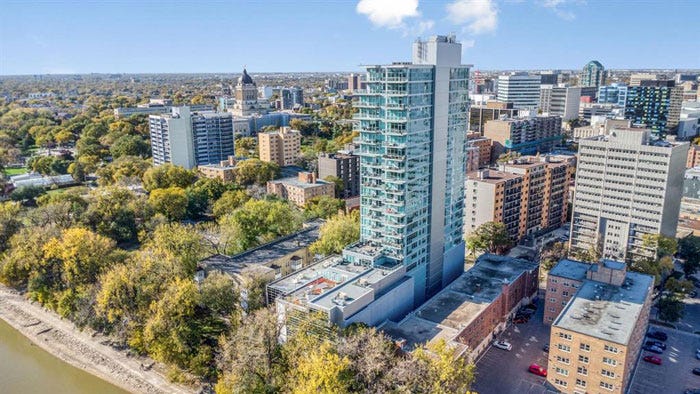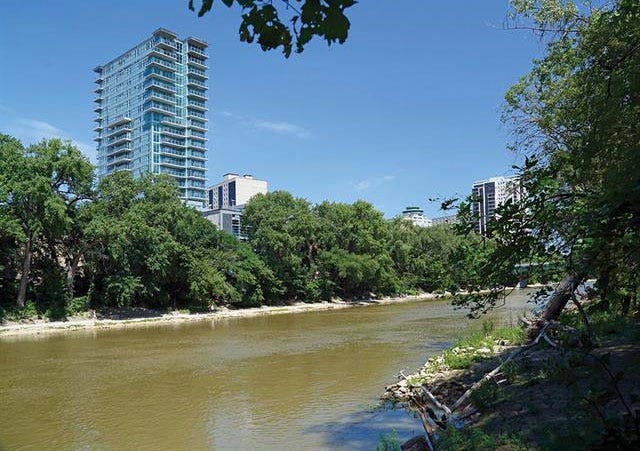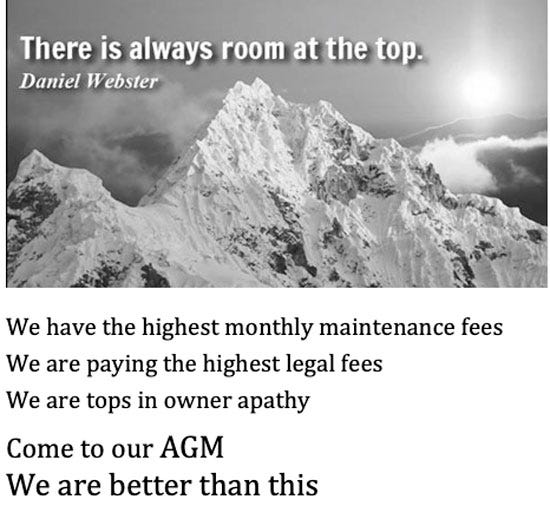The tall glass-walled building is the 390 Assiniboine Avenue.
Assiniboine condo residents, overwhelmed by encampment chaos, send SOS to Premier Kinew
Winnipeg Sun
Marty Gold
Dec 20, 2024
Living near the Forks (of the Assiniboine and Red Rivers) is used as a selling point by the City of Winnipeg to get older people downsizing or retiring to move into downtown Winnipeg.
Some who liked the concept bought a condo at 390 Assiniboine along the Assiniboine River. The last thing they expected was a problem with the neighbours.
But when the definition of “neighbours” morphed into allowing violent homeless criminals to occupy McFadyen Park, the problems proved an around-the-clock nightmare.
The condo residents have endured a barrage of graffiti, drug dealing, theft, vandalism, car break-ins, robberies, assaults, and a parade of stolen bikes heading to the chop shop at all hours. They also see and hear the turmoil on the Fort Rouge side of the river.
woke 21st-century civic government
They turned to the City of Winnipeg for help. What they got, was a lesson in woke 21st-century civic government, where politics, ideology, and disregard for taxpaying residents is accelerating the decline of Winnipeg’s downtown.
unsafe River Trail
Theresa Hunter provided The Sun with an email sent to area councillor Sherri Rollins, Mayor Scott Gillingham, nine other councillors and other officials on Sept. 24. She outlined how, “It’s worse than it has ever been in the almost six years residents here have been trying to work with our Councillor Sherri Rollins and the City of Winnipeg.”
She noted that “the encampments continue to grow along the Assiniboine Ave., riverbank and more people with mental health problems and addiction issues are living untreated without support and making the area, our community and the River Trail more unsafe.”
“Four Winnipeg Fire Paramedic Service (WFPS) trucks attended another open fire on Friday night.
Hunter also exposed how the “mindful cleanups” conducted by city-funded agencies are a charade.
Downtown Community Safety Patrols come in and pull out some garbage and leave it in a pile for pickup and the homeless rifle through it and drag more back into the encampment. Repeat the following week in a never-ending cycle. Remains of a fire from April 6 are still evident on the riverbank.”
open defecation
When I met with Hunter and some other residents, I learned they share the same experiences as people living near Mostyn Park, at 300 Assiniboine, and at 500 Waterfront that I’ve reported on this year. The city is allowing the homeless to dictate their quality of life.
Randie Einarson grew up in the West End, then moved to Toronto for 10 years. She lived just south of the city before moving downtown in August of 2023.
“We have our own walkway to the riverfront, and you could see the tents, the mess, the garbage. I’d never seen that before. It was kind of shocking.”
What she’s seen has included stolen electricity, blazing fires, open defecation on property, in parks and into the rivers and innumerable discarded needles.
The river walk extends from the Forks west through Bonnycastle Park, past
McFadyen Park, and to the Osborne Bridge. This is what tourists get exposed to
when they walk by.
But Einarson and her fellow tenants have to live right next to it.
One of the taxes the condo owners pay is the Community Revitalization Tax, that is “imposed and is payable in lieu of school taxes.”
But these lawless encampments are wrecking their community, not revitalizing it. It’s insult after injury to make them pay it.
She believes that their property taxes should be reduced because of the squalor and danger residents face. But when it was raised by “a bunch of us” who brought photos to appeal their assessments, “they were pretending they didn’t know about this.”
Politicians scared to act
Another resident, Eric Grehan, served in the military for 36 years in war-torn posts like Lebanon and the Sudan before eventually settling into the condos. Retirement has hardly been “quiet” for him.
“One of the things I came to find out pretty quick is we have organizations that are for-profit so they have no plan to go out of business. There’s an encouragement to feed an ongoing scenario we find ourselves in.”
Grehan believes the Charter rights of the homeless have been distorted by the courts to the point that “their interpretation is simply wrong. If you don’t understand the difference between right and wrong, you shouldn’t be in that position. And our politicians here are scared (to act).”
“There’s no toilets or washroom facilities (near the encampments). There’s needles throughout McFadyen Park. I mean, there’s filth, and then there’s filth.”
people don’t understand history
His view is that people don’t understand history and when mental health facilities were closed down decades ago, “the result shows up on our streets, with nothing in our plans to look after these people in a long-term way.”
“The basic mistake is feeding their drug habits. To me it’s criminal. Even if they find these folks homes, there’s no guarantee they won’t be back here.”
Grehan was assaulted going to play pickleball in the park but at least his assailant didn’t have an “edged weapon.”
Another resident who has since moved — a City employee — was attacked by an aggressive riverbank addict swinging a hatchet.
just a nice homeless guy
Charges were filed with the police and a restraining order issued. The goon continued to show up and utter threats on three other occasions, yet one media outlet portrayed him as just a nice homeless guy keeping the riverbank clean.
city enabling the homeless to deteriorate
People are living in hell on the riverbanks and they’re making life hell for residents trying to live their lives in peace.
As Hunter points out, “encampments are detrimental to public safety and the psychological well-being of all other citizens as neighbourhood viability declines.”
The city policy asserts it’s a “human right” to live and die in a riverbank encampment and promotes so-called harm reduction.
That approach doesn’t even meet the basic needs of the campers but does result in needing to send in fire and emergency crews two or three times a day.
“Addictions and mental health issues cannot be treated or supported when someone is living under a tarp,” Hunter said. “The practice increases crime, disorder and biohazards. Allowing and enabling the homeless to deteriorate on our streets when they are not capable of caring for themselves is not humane.”
Mayor Gillingham met with some of the residents in May and according to Hunter’s notes, “he advised that the encampments on the Assiniboine River banks will be permitted indefinitely until housing can be provided.”
Einarson and Grehan mentioned that there are no encampments near individuals like Gillingham who are making decisions that undermine others’ safety and that of everyone else downtown.
Many of the condo owners have a view of the Manitoba Legislature. Since the City of Winnipeg refuses to take any action to protect the neighbourhood, I asked Hunter what message they would like to send Premier Wab Kinew.
“Please, help us. Please.”
This news story has a far different slant about homeless encampments that what we usually get from the mainstream media. It is from the point of view of middle-class seniors who bought their dream condo only to find that a homeless encampment moved in next door at the river front park. That park was suppose to be a major selling feature.
The writing is direct and blunt.
“They turned to the City of Winnipeg for help. What they got, was a lesson in woke 21st-century civic government, where politics, ideology, and disregard for taxpaying residents is accelerating the decline of Winnipeg’s downtown.”“One of the things I came to find out pretty quick is we have organizations that are for-profit so they have no plan to go out of business. There’s an encouragement to feed an ongoing scenario we find ourselves in.”
“Addictions and mental health issues cannot be treated or supported when someone is living under a tarp,” Hunter said. “The practice increases crime, disorder and biohazards.”
“Mayor Gillingham met with some of the residents in May and according to Hunter’s notes, “he advised that the encampments on the Assiniboine River banks will be permitted indefinitely until housing can be provided.”
The mayor doesn’t say when housing will be provided. Why? Because sufficient housing that is needed for all addicts and the mentally ill in Manitoba will never be built. The construction and annual operating costs for full service support housing are far too high.
Journalist-activism is very common now. It refers to reporters who write to support their world-view rather than the facts. Here we have two different reporters describing the same homeless man. One calls him a “goon” with a restraining order while another “portrayed him as just a nice homeless guy keeping the riverbank clean”.
What can the condo residents do?
They’re retirees so they have the time and they should be motivated.
Report all crime to the police. Keep a spreadsheet of all incidents including date, type of incident and who was called: city services, ambulance, fire services or police, and all incident report numbers.
They also need to get political involved:
• write letters to the local media.
• try to get their property taxes reduced.
• involve their residential neighbours and the local BIA.
• information protests at your provincial MLA’s office and the Manitoba Legislative Building.
They definitely must get organized far ahead of the next municipal elections in order to replace their councillor and try hard to defeat the mayor.
News Flash
Winnipeg to implement new homelessness plan in 2025
Global News (abridged)
Iris Dyck
24 December 2024
The City of Winnipeg and the province of Manitoba will introduce a plan to clear out encampments and move people into housing in 2025, Mayor Scott Gillingham and Premier Wab Kinew tell Global News.
Kinew said service providers will move “camp by camp” and move people into housing with “wraparound” addictions and mental health supports within 30 days. Once all the people in the area are housed, they will not be able to return, though Kinew didn’t elaborate on how that would be enforced.
The plan will see all service providers working together, Kinew and Gillingham said.
“The province, the city, there’s a role for the federal government, Indigenous governments, non-profit sector, private sector, all moving in the same direction in a co-ordinated effort to address homelessness,” Gillingham said.
Gillingham said the city has set up a “non-profit housing concierge” for service providers. “That person makes one call to one person and that person helps them navigate all things related to getting their housing built,” Gillingham said.
Kinew says the province has acquired housing to support the plan.
“When there’s legal challenges or roadblocks put up to moving people out of tents, it relies on the argument that there’s not sufficient housing units for those folks. We believe we’ve addressed that,” he said.
Siloam Mission CEO Tessa Blaikie Whitecloud says the organization was consulted on the project, and plans to build 700 to 1,000 housing units within the next 10 years. She says while there are about 3,500 people experiencing homelessness in Winnipeg, there are only roughly 100 housing units in the city that rent at the level someone on employment and income assistance can afford.
St. Boniface Street Links founder Marion Willis says it’s a “significant step forward. I feel a bit validated because that’s exactly what our team has been doing now for the past four or five years,” she said.
Social Planning Council of Winnipeg executive director Kate Kehler is looking forward to more details on how the plan will be funded.
“When I say details, I’m actually talking about resources, as in money, in order to help everybody co-ordinate. Co-ordination does not come free. In fact, it’s not inexpensive even. But the teams already out there, they’re already doing the work. They already know how to work together. But there has to be substantial, substantial resources put towards allowing them to co-ordinate properly,” she said.
Downtown Community Safety Partnership executive director Greg Burnett: “I think the fact that we’re all talking at all levels of government again and all the organizations who are working on this is success,” he said.
Reading this very carefully, it looks to me that the city and the province will introduce a plan in 2025. Planning is one thing; actually building the homes may come much later. Much, much later.
The city now has a “non-profit housing concierge” who people call and he/she then calls people. Sounds like they are bringing back a telephone operator.
One NGO says “our team has been doing exactly that for the past four or five years”. Did they have any success?
Another one says they need money in order to help everybody co-ordinate.
I suppose they need to plan how much money they need to start organizing the plan. Only then can they plan how many millions they will need to build and then operate the required housing.
Winnipeg has 3,500 homeless & all are going to be housed with full supports. When will that happen? How does NEVER sound.
This is a leaflet that I made for a condo corporation in the GTA area. It helped get a good turnout at the AGM.
Upstairs, downstairs: condo owner sues both neighbours over noise
After losing 4 small claims court cases, Linda Woo was ordered to pay $50 to neighbour she accused
Jason Proctor
CBC News (abridged)
Sep 02, 2024
A year after unsuccessfully suing her downstairs neighbour for making too much noise, a B.C. woman has also failed in a bid to sue her upstairs neighbour over similar complaints.
A small claims court rejected Linda Woo's claim against upstairs neighbour Lorenzo Bruno last week — instead ordering the Burnaby woman to pay Bruno $50 recompense for "unreasonable ceiling-tapping and cupboard-slamming" she made in response to his alleged noise making.
The B.C. Civil Resolution Tribunal decision is the latest chapter in a strata saga that spans years, involving multiple complaints to both the strata council and police, who described Bruno's noises at one point as him just "going about his life."
'A particular sensitivity to noise'
In the latest round of hostilities, Woo sued Bruno for "running appliances during quiet hours, entertaining guests, stomping, dragging furniture, dropping objects,... slamming cupboards,... a motorized exercise bike and flooring creaks, knocks and pops."
Bruno countered by claiming he was the victim, and that "Woo's constant complaints to the strata and the police amount to harassment."
In regards to Bruno — the upstairs neighbour — the latest tribunal decisions say Woo made more than 300 complaints, mostly about "creaking, popping and knocking noises" related to his flooring.
In his defence, Bruno admitted he had used his washing machine during quiet hours shortly after moving in — once.
But he denied making a "motoring noise" and the evidence was unclear as to whether other sounds like an "abnormal snapping" or "humming noise" came from his suite or the building itself.
By contrast, tribunal member Megan Stewart found Woo admitted "tapping" on her ceiling to get Bruno's attention and submitted a recording of a call to police where she said she "poked" her ceiling and slammed her cupboard "so that he would understand."
Based on those admissions, Stewart ordered Woo to pay Bruno $50 for creating a nuisance — a finding she said she couldn't reach in regards to Woo's claims.
"Though I accept the noises Ms. Woo hears bother her, I do not agree that on an objective basis she has shown they rise to the level of negligence or nuisance," Stewart concluded.
"Living in a strata building involves some degree of give and take among neighbours when it comes to noise and other potential nuisances."
A condo resident like Linda Woo can be a headache, not just to her neighbours but to the property manager and the Board of Directors.
Some people just can’t adjust to community living. It may be best if she could move to a detached house; perhaps in a smaller community where prices are lower.
















Good morning Strata Homeowner 101:
Thank you for your comments.
You say that "It will cost her somewhere between $50K and $100K and she/her lawyer will have to prove that the CRT decision, on its face, is “patently unreasonable”'.
I almost never advise any condo/strata owner to initiate a court application against their condo corporation let alone a government agency. I sued my condo corporation twice and although I won, and received my legal fees, it was not much of a victory. I moved.
I have no idea what the odds are for winning an appeal of a CRT decision. Only a BC lawyer who is experienced in strata law could give a knowledgeable opinion.
We don't know how reasonable Linda Woo's complaints were. It is likely that she is noise-sensitive. I still think that it would be best for her to move.
H. Marshall
Hello Mr. Marshall
The solution Jason Proctor of CBC, and now you (for him) propose for Linda Woo is not viable or fair. Not everyone can afford to move and a noisy non-compliant neighbour should never be the reason. Linda Woo should be able to count on her strata to intervene. She has documented and submitted her complaints over the years.
The BC Strata Property ACT (and nearly all other CRT decisions regarding nuisance) require the strata to properly and comprehensively investigate all claims of nuisance and it must enforce its bylaws. Nuisance has a very particular exacting definition to do with use and enjoyment of one’s home, which is a fundamental right. The interference with the quality of her life is what Linda Woo was/is required to prove, meaning the impact on her. She is required to prove her case on the balance of probabilities not ‘beyond a reasonable doubt’ .. the latter standard is reserved for criminal court. She is not required to prove that the noise reaches a certain decibel level… that is strata’s job. Investigation falls under the legal obligation (case law) to maintain per the Guenther decision by the BCSCourt and per the Quackenbush decision by the CRT. The CRT does not and cannot enforce its own ‘orders’
Linda Woo was clearly frustrated and exhausted but at least she was honest in saying she tapped on her neighbour’s ceiling to help them understand. Megan Stewart’s decision was biased and unfair in the opinion of many here in B.C. Please don’t target Linda Woo more now, in social media.
Strata is charged with investigating and following through with bylaw enforcement but that too can be a daunting and expensive task as it boils down to expensive testing UNLESS they are instead able to win the cooperation of the noise makers (in this case….. keeping in mind that nuisance complaints are of a wide variety, and not always noise related).
Keeping someone awake at night most nights for years because you are unwilling to buy a few area rugs, or felt pads for your chairs or keep the music down after 10 p.m. is, plain and simple, unreasonable! Remember, we don’t get to see the evidence submitted to the CRT and we do not really know if it has been read, let alone carefully, nor whether the single adjudicator making the decision has the skills, experience and dedication to be fair or even to deliver a basic form of justice. We don’t have any version of the open process that was formerly available via the actual court system.
Linda Woo, if she has the youth, tremendous energy required and a ton of money, now has only one option left and that is to make application to the B.C. Supreme Court for a judicial review of the CRT’s decision. She must apply to do that within 60 days of the decision. The work involved is colossal. There is no appeal process in BC, only a judicial review. It will cost her somewhere between $50K and $100K and she/her lawyer will have to prove that the CRT decision, on its face, is “patently unreasonable” and that is defined to mean, that without going over the decision line by line, or in any detailed way, the judge must be able to determine that the decision bordered on, or was absurd. Even if the judge does find that, they must, most often, defer to the Tribunal and send the decision back to the CRT for reconsideration. There are a few exceptions that allow for the judge to make the decision on its merits, himself or herself.
So goes the merry-go-round in B.C. with the application of the law and justice now illusive for strata homeowners.
Please don’t be too hard on Linda Woo. Long before she applied to the CRT she had tried everything else to creatively problem solve and win the cooperation of her neighbours and her strata council. She has lived with a nightmare. I have direct knowledge of what her realities have been. Moving to single family housing is now an option only for the most wealthy in BC! Moving to another strata may mean jumping from the frying pan into the fire. It may also mean moving out of community that has been yours for many years and away from the resources one has relied on for the same length of time. That is NOT a reasonable or viable option for most and both selling and buying are extremely expensive! BC has now added yet another tax for ‘flipping’ that means a huge penalty for anyone who buys and then sells within two years. If you find yourself living under a nasty noisy neighbour, you are stuck with paying the huge extra tax if you move before 2 years have gone by. The tax may reduce flipping and treating homes like they are just a commodity but it won’t help people in Linda Woo’s predicament.
The CRT, at best, delivers a very rough form of justice and says so itself. It is not a court process and it is unfair to suggest, as you of Jadon have, that it is. What you have, in Ontario, is something far better although I am told it too needs lots of improvement.
BC strata homeowners now MUST make application to the CRT first for nearly all strata related matters, even if hundreds of thousands of dollars are involved. Unlike the motor vehicle claims and small claims sections of the CRT, where there is a dollar limit on claims that can be made, the strata division of the CRT has no dollar limit. Some adjudicators are not lawyers! Their decisions can and do have profound impact on the lives of owners!
Far better is any version of neighbours being actual neighbours and respecting the rights of others to use and enjoy their home. Settling matters in-house is far better for everyone and the money strata spends on lawyers can then instead be spent on the building(s). However, this does require actual cooperation which seems to be close to extinct in B.C. Stratas!
Meanwhile, the B.C. government could upgrade and update its sloppy building codes to better control for noise, eliminate smoking (of anything) in multi-family complexes and generally change the 25 year old Strata Property ACT which hasn’t been changed in any meaningful way for a quarter of a century! Any changes they have made just help developers to toss up more shoddy buildings in a big hurry. Owner rights now nearly always take back seat to the perceived rights of developers, management companies, rogue strata councils (boards), insurance companies and a host of industry insiders and of course, lawyers, all being paid for by the same owners whose rights are going fast, or are already gone.